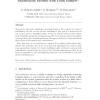Free Online Productivity Tools
i2Speak
i2Symbol
i2OCR
iTex2Img
iWeb2Print
iWeb2Shot
i2Type
iPdf2Split
iPdf2Merge
i2Bopomofo
i2Arabic
i2Style
i2Image
i2PDF
iLatex2Rtf
Sci2ools
JPDC
2010
2010
Stabilizing leader election in partial synchronous systems with crash failures
This article deals with stabilization and fault-tolerance. We consider two types of stabilization: the self- and the pseudo- stabilization. Our goal is to implement the self- and/or pseudo- stabilizing leader election in systems with process crashes, weak reliability, and synchrony assumptions. We try to propose, when it is possible, communication-efficient implementations. Our approach allows to obtain algorithms that tolerate both transient and crash failures. Note that some of our solutions are adapted from existing fault-tolerant algorithms. The motivation here is not to propose new algorithms but merely to show some assumptions required to obtain stabilizing leader elections in systems with crash failures. In particular, we focus on the borderline assumptions where we go from the possibility to have self-stabilizing solutions to the possibility to only have pseudo-stabilizing ones. Key words: Fault-tolerance, self-stabilization, pseudo-stabilization, leader election.
| Added | 28 Jan 2011 |
| Updated | 28 Jan 2011 |
| Type | Journal |
| Year | 2010 |
| Where | JPDC |
| Authors | Carole Delporte-Gallet, Stéphane Devismes, Hugues Fauconnier |
Comments (0)

